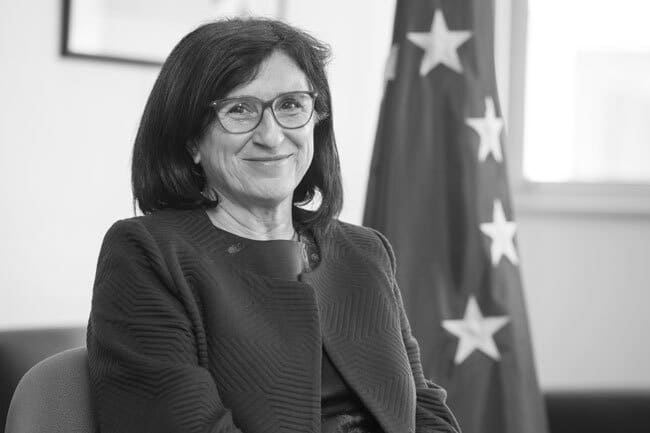Dominique Perrut, economist, associate university professor and member of the Confrontations Europe Finance Steering Committee, analyses the main priorities of the post-Covid 19 recovery plan in a context of war in Ukraine.
Europe was hit harder by the sudden pandemic than its major competitors, but it has taken energetic measures in order to make the dual transition, climate and digital, the driving force behind its economic recovery. A brief economic and social diagnosis of the Union after two years of health crisis will lead us to identify the three challenges that the continent must now face: the convergence of national economies, the management of transitions and the fight against social dumping and exclusion. We will also attempt to assess the economic consequences of the war unleashed by Russia in Ukraine and the impact of European responses for energy independence on the climate transition. After a discussion on these issues, we will formulate the priorities that the French Presidency of the EU Council should take into account in these areas.
I – The EU faces the challenges of convergence and social precarisation[1].
The pandemic has widened the divergence between national economies, to the detriment of the countries of the South[2]. As a result, the vigorous and necessary recovery measures taken by the Member States have led to a sharp increase in public deficits and debts in these countries. These interventions have enabled employment to be maintained to a large extent, but have not prevented the deterioration of the social situation, which was already worrying before the crisis. People at risk of poverty or exclusion represented more than one fifth of the EU population in 2020, i. e. 98 million people[3]. The proportion is even higher in the south of the continent. In these countries, young people are hit by an unemployment rate of over 30%, accompanied by a high level of marginalisation.
The European response to the 2020 recession has taken four forms: – anti-crisis measures (with the SURE mechanism), for a total amount of €365 billion; – the Recovery Plan (Next Generation EU), i.e. €750 billion over 3 years; – these actions are supplemented by the Union’s classic tools, the European Budget (2021-2027), for an amount of €1.074 billion ; – within this, the initial public guarantee of the Investment Plan (InvestEU), i.e. €26.2 billion, which should lead to around €400 billion of investment. Overall public intervention will thus reach a total of around €2,800 billion and 24% of Europe’s GDP, a proportion comparable to that of the United States.
The Russian invasion of Ukraine has upset the optimistic forecasts established at the end of 2021. While the eurozone economy was expected to continue to rebound strongly in 2022 (+4.2%, after GDP growth of 5.4% in 2021[4]) after the recession created by the pandemic, the war that broke out at the end of February is causing a shock to both supply and demand. This shock will spread to the economy through three channels[5]: – that of inflation, following the rise in the price of imported energy and certain raw materials; this will weigh on the production conditions of companies, as well as on household consumption; – that of external demand addressed to Europe by its partners; this will be weakened by the lower growth in their countries; – finally, that of uncertainty, leading to a slowdown in consumption, and no doubt investment, as well as probable disturbances on financial markets.
The first forecasts taking into account this conflict conclude that growth initially forecast for 2022[6] will slow down. The growth rate would be between +3.7% and 2.3% for the euro zone, depending on the scenario adopted, compared with a rate of +4.2% for the forecasts made at the end of 2021.
In this disrupted environment, the ECB’s monetary policy should change significantly. On the one hand, faced with the very likely rise in inflation (i.e. a newly forecast rate of 5.1% in 2022, compared with a previous forecast of 3.2%), the ECB will probably raise its key rates. On the other hand, sovereign asset purchases probably will not remain as accommodating in the light of the high level of public debt (92% of GDP in the euro zone in 2021[7]). For their part, in their macroeconomic choices, political leaders, at least in southern Europe, as well as in France and Belgium, will be caught between the strong temptation to continue the public stimulus and the need to reduce debt in the face of a cost of debt that could rise rapidly, under the effect of rising interest rates and probable tensions on financial markets.
In addition to the major uncertainties of the current economic situation, this brief overview highlights the three main challenges that the Union must now face: – firstly, to ensure a recovery capable of promoting the convergence of economies; – secondly, to carry out the twofold transition, climate and digital; – thirdly, to respond both to the threats of social dumping and to the situation of massive social exclusion which prevails in several countries. These major challenges deserve some clarification.
II- The climate transition and the social imperative
Questions on the EU strategy for environmental transition. The strategy for financing the climate transition devised by the international institutions[8] takes into account, on the one hand, the characteristics of innovative, high-risk, long-term green projects, and on the other hand, the scarcity of public capital in the face of the considerable needs of this transition. These represent between €500 billion and €1,000 billion per year for the Union, depending on the basis of the calculation[9]. It is therefore recommended to produce, from a very limited public impulse, very significant spillover effect, involving public-private partnerships[10]. Designed with this in mind, the European Investment Plan (now the InvestEU plan, 2021-2027) seeks to attract, by means of a very high multiplier effect, large volumes of public and private capital towards projects with European added value. This channelling of investment towards the needs of transition presupposes, in addition to such a public initiative, the establishment of a regulatory framework that provides strong incentives for sustainable investment, which is gradually being introduced in the EU. The European strategy for transition is thus deployed along three axes:
- The establishment of a regulatory framework for sustainable finance to direct private financial flows towards sustainable economic activities. This programme, outlined in the 2018 Sustainable Finance Action Plan[11] and updated in 2021[12], has three complementary components: a taxonomy to define and classify sustainable activities; a reporting obligation for financial and non-financial companies; and a toolkit for sustainable investment.
- The development of the Capital Markets Union, which should allow the circulation of savings and investment within a truly single market. Indeed, the double transition will rely on the creation and development of many innovative companies. These will require equity and other long term capital for projects that are by nature very risky. Conventional banks are not designed to meet such needs. The two Action Plans on Capital Markets Union of 2015[13] and 2020[14] are aimed precisely at moving, with a strategy of small steps, towards the establishment of a single market for financing, to meet such demand.
- Public investment in the EU, of which one third, or around €800 billion in total between 2021 and 2027, will be devoted to the climate transition.
This overall programme is certainly ambitious, but it does raise questions. Are these three sets of measures in this draft sufficient to build a coherent industrial policy for the transition? By whom and how will the major technological choices be arbitrated, which will make the successes or failures of tomorrow? What respective place will be given to the electric vehicle compared to the hydrogen vehicle? What should be the place of nuclear and gas, a burning issue today, in energy policy?
We can also question the capacity of the 2020 action plan on the Capital Markets Union to meet the requirements of the transition. This presupposes, in particular, that massive transfers can be made within the continent, from the countries of the North, which have a large surplus of capital, to sustainable investments in the South. It would therefore be appropriate to evaluate, with a view to the necessary reorganisation of capital flows in the Union: – the capacity of the private equity sector in Europe to meet the needs of innovation; – the availability of sufficient tools in order to protect cross-border investments against country risk.
The war in Ukraine is accelerating the transition agenda. The conflict highlights Europe’s heavy dependence on Russian gas and oil. Indeed, the EU is almost entirely dependent on its imports for gas[15]. Russia provides 40% of its total gas consumption, more than a quarter of its oil imports and almost half of its coal imports[16].
In response to this emergency, the European Commission has just published the REPowerEU plan with immediate and long-term actions[17]. The urgent actions include – on the one hand, a legislative proposal to make it compulsory to fill gas stocks to 90% of their capacity by 1 October each year; solidarity mechanisms between States are foreseen; – on the other hand, instruments to regulate high energy prices in favour of households and companies, including State aid.
In the longer term, this project is aimed at ending energy dependence on Russia « well before 2030 », while strengthening the resilience of the European energy system. The measures envisage the rapid diversification of EU gas imports and build on the measures of the July 2021 « Adjustment to Target 55 » programme[18] to intensify them. Firstly, diversification of gas purchases would be achieved through : – the use of imports from non-Russian suppliers, consisting mainly of LNG[19], as well as gas transported by pipeline; – increasing the production of biomethane and hydrogen. Secondly, the plan aims to accelerate the electrification of Europe from green energy, pushing the « Adjustment to target 55 » timetable. These measures concern: housing (energy efficiency actions, installation of solar roofs and heat pumps); the electricity sector (acceleration of wind, solar and green hydrogen programmes); electrification of industry.
In total, according to the REPowerEU plan, two thirds of Russian gas imports could be replaced as early as the end of 2022[20], in particular as a result of diversification towards other global suppliers, before total replacement in the coming years. In the urgent need to move away from energy dependence on Russia, this programme and its other measures will lead to a further acceleration of the energy transition, following the upward revision in 2021 of the Union’s environmental objectives.
Tackling both social dumping and exclusion. The phenomena of poverty and exclusion that we have highlighted within the Union are likely to worsen, as a result of persistent divergences in the growth trajectories of countries. The double transition itself will put pressure on the most vulnerable social categories[21]. This is particularly the case because of the effects of fiscal and regulatory policies, such as ecological taxes on energy, performance standards for vehicles, and carbon pricing.
The situation of vulnerability faced by a significant proportion of the European population today is in flagrant contradiction with the Union’s values of equality, justice, solidarity and protection of human rights, as well as with its objectives of well-being, social protection and fight against exclusion. These values and objectives are proclaimed in the Treaties[22]. Ethical requirements, political reasoning and also economic reasoning force us to confront this yawning gap between principles and realities.
The European Socle of Social Rights states in its preamble that « economic progress and social progress are closely linked »[23]. The document further stresses that social problems, including unemployment, are to a large extent the result of relatively modest growth, stemming from untapped potential in productivity and participation to employment. This creates a downward socio-economic spiral of exclusion.
For a long time, Europe has been concerned with ensuring a supra-national framework for growth, mainly through the single market. In turn, the burden of distributing wealth and opportunities, including in the social sphere, fell to the Member States. Over time, however, social responsibilities have been devolved to the Union in many areas such as: free movement of workers, social policy, dialogue between social partners, equal pay for men and women, education and vocational training.
Europe’s single market policy has opened the continent to globalisation. Similarly, major decisions concerning the environment are taken by the Union. These policies are not without social consequences. Europe cannot therefore leave it to the Member States to manage the social effects of these policies[24].
Proclaimed in 2017 by the EU, the “European Pillar of Social Rights” is now the basis for future EU social policy and regulation in this area. In our view, it is important to distinguish two distinct issues in this document. On the one hand, in its chapters 1 and 2, the Socle aims to avoid social dumping within the single market. This is based on the notion of a level playing field, or competition on a harmonised basis between countries. On the other hand, in chapter 3, the Socle aims to combat poverty and exclusion. These notions cover several forms of deprivation, ranging from insufficient income to fuel poverty, poor housing and difficulties in accessing essential services. Yet, in front of the impoverishment of certain categories of the population in the Union, we find few strong measures in the European social agenda[25]. This gap must be filled.
III- Promoting economic convergence, successful transitions and social inclusion
The three challenges identified above, as well as the examination of the responses recently made by the Union, lead us to formulate, during the French Presidency of the EU Council, proposals around three themes: – strengthening economic governance; – consolidating the framework for climate transition; – tackling social dumping and exclusion.
Strengthening economic governance to consolidate the euro. The freezing of budgetary rules until the end of 2022, the sustained exchanges between the Member States and the Commission during this time, and the existing consensus on the shortcomings of economic coordination, create a unique window of opportunity to modify the rules of governance without delay. Three actions should be considered.
- Revise the Stability and Growth Pact. This involves simplifying a system that has become unreadable, without changing the Treaties, by retaining two key indicators for budgetary matters: a rule for the evolution of current public spending as a function of GDP, and a ceiling ratio for public debt. In such a framework, the necessary expenditure for public investment, in particular for transition and social cohesion, must be excluded from the calculation of the budget balance.
- Create without delay a post of Minister of Economy and Finance for the Eurozone. Already in place for foreign affairs, such an institutional arrangement would provide a key asset to consolidate the euro area[26].
- Re-launch the proposal for a budget to stabilise the euro area. The lack of budgetary capacity with stabilisation elements hampers the proper budgetary steering of the euro area. Two alternative or complementary proposals can be put forward for discussion: – a budget for the automatic stabilisation of public investments in the event of a country’s recession[27]; – an unemployment insurance tool, which could be progressively put in place on the basis of the perpetuation of the SURE system.
Consolidate the environmental transition mechanism. The implementation of the Carbon Border Adjustment Mechanism is high on the French Presidency’s agenda. For the Emissions Trading System (ETS), which complements it, it would be wise to assess the appropriateness of basing the revenue of the new Social Fund for the Climate on the ETS as a whole and not just on its extension. Furthermore, the social consequences of extending the ETS to the building industry and road transport should be examined[28].
The financing of disruptive innovation is a central issue for the transition. Therefore, it would be necessary to assess the situation of European capital investment situation in relation to the specific capital needs linked to the current changes.
The European programme for « more affordable, secure and sustainable energy » is likely to be strengthened and accelerated with the adoption before summer 2022 of the REPowerEU plan for housing, power generation and industry. This project should be followed closely.
Tackling social dumping and exclusion. Three sets of actions should be considered.
- Fulfil the ongoing « social anti-dumping » agenda. Two measures are mainly concerned here. On the one hand, the October 2020 proposal for a directive on « Adequate Minimum Wages » should soon be able to be agreed politically[29]. On the other hand, the regulation of the conditions of workers on digital platforms has just been the subject of a legislative proposal[30] and is one of the priorities of the French Presidency.
- Take flagship initiatives against exclusion. In this area, it seems important to adopt a landmark decision on minimum income, instead of the simple recommendation envisaged by the Commission. A legislative proposal could be drawn up on the principle 14 of the Pilllar[31], once the type of minimum income chosen has been decided. Other initiatives should be taken to tackle fuel poverty, which affects 34 million Europeans[32], housing (homelessness is on the rise in most countries), and lack of access to essential services (water, health, financial services, digital communications).
- Integrate the social dimension into all EU policies. This would involve the adoption of a principle that all new legislative proposals should include a social impact assessment with reference to the European Pillar of Social Rights. This reform is based on the Treaties[33].
*****
In response to the brutal shock of the recession linked to the pandemic, the Union was able to launch an ambitious recovery policy, largely focused on the climate transition, whose heightened requirements have made room for solidarity. France, as part of its Presidency of the Council of the European Union, can reinforce this movement by taking initiatives in three directions.
Firstly, it must seize the rare window of opportunity to reform economic governance in order to bridge the division between countries within the euro zone. Secondly, as part of the transition process, in addition to the introduction of the Carbon Adjustment Mechanism at the borders, the system for financing innovation must be brought up to speed. The urgent search for energy independence, linked to the Russian conflict, will no doubt hasten the transition programme. Thirdly, in the social field, the indispensable anti-dumping measures must be accompanied by a policy, which is largely absent today, to eradicate exclusion.
The Union must take firm responsibility for the social issue for ethical reasons, because it is one of its founding values, for political reasons, because the European project cannot continue without social cohesion, and also for economic reasons, because the development of human capital is a factor of growth. Europe must still deserve the image it claims, that of a leader in the field of the environment and a model of social inclusion. France now has additional resources to contribute to this.
Dominique Perrut, Doctor of Economics (Paris-1) and independent researcher in Paris. He is the author of papers, articles and books on financial intermediaries, regulation and the European economy (L’Europe financière et monétaire, Nathan; Le système monétaire et financier français, Seuil, coll. Points).
He has taught European economics in France and in Europe (1992-2013). He participates in the work of several European Think Tanks and NGOs. He is a member of the Steering Committee of Confrontations Europe.[33] Specifically in Article 3.3 of the Treaty on European Union and Article 9 of the Treaty on the Functioning of the European Union.
Footnotes:
[1] This article summarises and updates the main points of the study carried out by the author for Confrontations Europe: « La relance européenne post-Covid face aux enjeux des transitions et de l’équité », December 2021. It can be referred to for further details.
[2] Perrut D., « Which steps to strengthen the euro? » Revue Banque & Stratégie, n° 384, October 2019.
[3] People at risk of poverty or social exclusion as % of total population. Source: Eurostat.
[4] European Central Bank, Macroeconomic projections for the euro area, March 2022.
[5] Banque de France, Macroeconomic projections for France – March 2022.
[6] ECB, op. cit.
[7] ECB, op. cit.
[8] OECD, UN Environnement, The World Bank (2018), Financing Climate Futures, Rethinking Infrastructures, novembre. UNEP (2018), « Inclusive Wealth Report »
[9] Communication from the Commission: « The EU economy after COVID-19: implications for economic governance ». COM(2021) 662 final.
[10]. D. Perrut, “Getting a grip on the climate challenge to build the future of Europe”, Fondation Robert Schuman, European Issue, n° 500, 28/01/2019.
[11] Communication from the Commission: « Action Plan on Sustainable Finance », COM(2018) 97 final.
[12] Communication from the Commission: « Financing the transition to a sustainable economy », 6.7.2021, COM(2021) 390 final.
[13] Communication from the Commission , « An Action Plan to build a Capital Markets Union », COM(2015) 468 final.
[14] Communication from the Commission: « A Capital Markets Union serving people and business – a new action plan ». COM(2020) 590 final. 4.9.2020.
[15] EU gas consumption is 90% dependent on imports (source: Communication from the Commission: « REPowerEU », op. cit.)
[16] Communication from the Commission: « REPowerEU: Joint European Action for more affordable, secure and sustainable energy ». COM(2022) 108 final, 8.03.2022.
[17] Communication from the Commission: « REPowerEU », op. cit.
[18] Communication from the Commission: « Adjustment to the 55 target », COM(2021) 550 final, 15 July 2021. This programme aims to accelerate the climate transition towards the EU’s target of reducing greenhouse gas emissions by 55% by 2030.
[19] LNG: liquefied natural gas.
[20] That is 102 billion cubic metres (bcm) of gas replaced out of a total of 155 bcm of Russian imports, according to the Commission’s figures (source: Communication from the Commission: « REPowerEU », op. cit)
[21] Laurent E., « La transition juste, un nouvel âge de l’économie et de l’environnement », Revue de l’OFCE, 165 (2020/1).
[22] Treaty on European Union, Art. 2, 3 and 6-1; Charter of Fundamental Rights, in particular Article 34-3; it should be recalled that since the Lisbon Treaty (which entered into force in 2009), this Charter has the same legal value as the Treaties of the Union.
[23] European Pillar of Social Rights, Preamble, point 11.
[24] Vincent Aussiloux, « Refonder l’Europe de la solidarité », France Stratégie, La Note d’analyse, April 2019, n° 75.
[25] See on this point the Communication from the Commission: « The European Pillar of Social Rights Action Plan », p. 4. COM(2021) 102 final, 4.3.2021.
[26] See on this point the articles by the author: « What steps to strengthen the euro? Banque et Stratégie, n° 384, October 2019; « How to consolidate the euro zone », European Issue n°500, Robert Schuman Foundation, 2018.
[27] This proposal is set out in great detail in the December 2017 « Package » on the reform of the euro, and then in the Commission’s « Package » of late May 2018.
[28] P. Bérès, Is the European Union serious about the social question? Confrontations Europe, La Revue, n° 132, Autumn-Winter 2021.
[29] Proposal for a Directive on adequate minimum wages in the European Union. 28.10.2020 COM(2020) 682 final.
[30] Proposal for a Directive on improving working conditions in platform work. 9.12.2021 COM(2021) 762 final 2021.
[31] European Pillar of Social Rights, Principle 14, Minimum Income: « Everyone without sufficient resources has the right to minimum income benefits adequate to live in dignity at all stages of life, as well as to effective access to goods and support services. For those who are able to work, minimum income benefits should be combined with incentives to (re)enter the labour market.”
[32] E. Magdalinski, M. Delair, Th. Pellerin-Carlin, « Europe needs an energy strategy to end fuel poverty », Jacques Delors Institute, February 2021.












